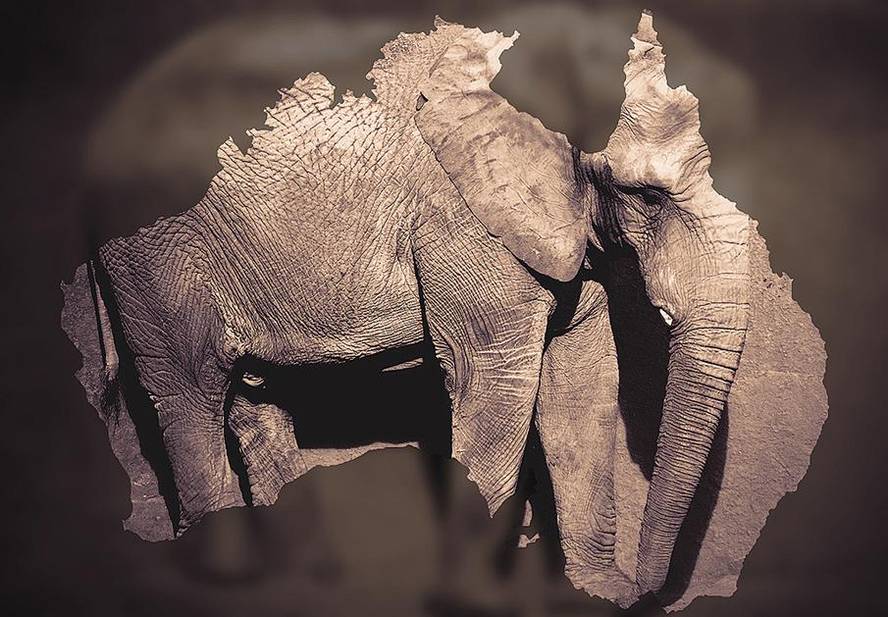Elephants in Australia
You may have seen or heard what an opinion article published in the journal Science has proposed: controlling a grass that has become invasive, introducing elephants... Australia.
An African grass species (Andropogon gayanus) was introduced and favored in the Australian savannah with the idea that it could be good for cattle. This species, which reaches four meters of height, begins to disperse uncontrollably in the continent, outside the control of the marsupial herbivores and the cattle of origin. It abandons the original plant species, becoming a new fuel for the fires so common in this continent, until aggravating its damages.
Thus, a researcher at the University of Tasmania proposes the introduction of substitutes for megabelarjantes, elephants and rhinos, which disappeared from Australia 50,000 years ago. In this way, both animal species would be destined to the biological control of the invasive herb, far from the lands of its origin Africa.
(des)Biological control
Examples of species introduced for biological control can be found in Australia, but not because they have worked, but because they have finally caused the ecological disaster. Two examples are the fox and the sugar cane toad. The case of the fox is known: this species brought to Australia to continue with the traditional foxes hunt that was initially held in England, was favoured to control the rabbit that was becoming a plague (which was among its hunting pieces in Europe). In the Australian lands, however, hunting pieces were found in the native fauna, much easier to capture by the foxes, which caused the disappearance or collapse of numerous species without affecting the population of rabbits. The other representative case, although less known, is that of sugar cane. In Queensland, sugar cane farming has been a very important economic activity since the transfer of the plant to Australia in the eighteenth. In the twentieth century. Due to the damage caused by a native beetle in the cane fields, and trying to avoid chemical remedies, the Bufo marinus toad, native to Central and South America, was introduced. At the beginning of the twentieth century, with the aim of controlling the beetle. It was a decision to repent. In addition to not affecting the beetle population that was intended to be controlled, there was a disaster for some Australian species. The animals that captured native Australian amphibians did not coevolve with the poison of this new toad and many of those who died or ate toads were deadly: the populations of marsupial cats and numerous reptiles have suffered a drastic decline for this reason. Bufo marinus continues to expand in Australia, especially to the west; at present it has reached Western Australia with 2,000 kilometers of travel and does not seem to be able to stop for the moment.
What consequences can the entrance of these great herbivores in Australia have? What damage could elephants or rhinos cause in the Australian ecosystem? What is happening with another species included in Australia, can give us a clue.
XIX. At the end of the 20th and beginning of the 20th century, thousands of dromedaries and camels were transferred to Australia, animals adapted to arid conditions that played an important role in the exploration and transport of the continent. When motor vehicles appeared and the train expanded, however, they stopped using camels and camels were free. What was initially a population of 20,000 individuals, has reached a population close to one million individuals. Today it is the largest herbivore living in Australia. In the places where his diet has been studied, it has been observed that he feeds not only on grass, but also on all available plant species, cutting down trees and shrubs to taste. They are also responsible for the extinction of some plant species they like. In wet conditions, camels get water from food, but have to drink in dry conditions: a camel thirst can drink 200 liters of water in three minutes. The damages that occur in infrastructures in search of water generate annual expenses of several million euros and a risk in the roads for the accidents that provoke.
Although they have been carried out with the best intention and with the best ecological knowledge of the time, numerous experiences of ecological control have had painful biological and economic consequences. Although ecological engineering has been very successful in many cases, especially in ecological restoration, it seems that the consequences of manipulating ecosystems cannot yet be guaranteed. Despite the simplest ecosystem, there are numerous and complex direct and indirect relationships between native species.
Just as medicine had not advanced much until we began to know the components and functioning of the human body, we will not be able to manipulate ecosystems until we understand well the species that compose them and their relationships. It is expected that the new methods currently used in the collection and treatment of information contribute to this.
After habitat disposal, invasive exotic species are the largest responsible for the current loss of biodiversity. As we have seen in the examples, many of the species used for biological control have become invasive, causing greater damage than the problem that was intended to be solved. On the one hand, it seems quite difficult to predict (to mention one) the effects that elephants can have on the vegetation of a new ecosystem. On the other hand, although it is proposed to do so in a controlled manner… how does this -- let's not forget -- in areas of thousands of square kilometers? I think taking elephants to Australia is adding new problems to a difficult situation. And also… who would dare the invading elephants?
--> And also: Chronicle of ecological disasters, books recommended by Xanti Larrañaga








